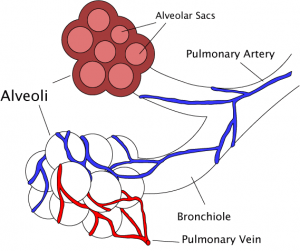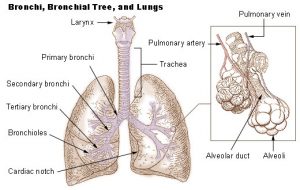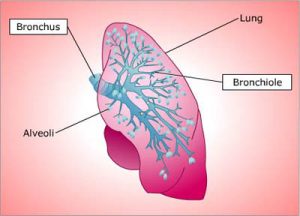Bronchioles Definition
The Bronchioles or the Bronchioli are the passageways through which the air reaches the alveoli (tiny air sacs) through the nose or mouth. In this, the branches no longer house the submucosa, cartilage or the glands.The Bronchioles divide into tinier terminal bronchioles, which are in the conducting zone of the respiratory system. These further divide into even tinier respiratory Bronchioles, that marks the starting of the respiratory area.
Anatomy of Bronchioles
As we take a breath, the air passes through the nose or mouth to the trachea. Then, it enters the main bronchus. As each bronchus keeps dividing, before becoming the bronchioles, these continue the task of fanning out till it reaches the respiratory system.
The different types of Bronchioles are:-
- Lobular Bronchioles,
- Terminal Bronchioles,
- Respiratory Bronchioles.
Bronchioles Function
The main function of the bronchioles is to conduct air from the bronchi to the alveoli, and also to control the distribution of air throughout the lung by constricting and dilating. The terminal and lobular bronchioles are called the dead space, that means there is no exchange of air in these vessels.
Bronchioles Location
It is a very small branch of air tubes inside the lungs, which happens to be a continuation of the bronchus.
Bronchioles Size
The diameter of the bronchioles is said to be below 1 mm, though the size can vary from 5 mm to 0.3 mm.
Structure Of The Bronchioles
Each lung has a primary Bronchi, the left, and right Bronchus. These give rise to the secondary bronchi., which in turn gives rise to the tertiary bronchi. The tertiary bronchi divide into bronchioles. These are different from the tertiary bronchi, where their walls do not have hyaline cartilage ( a cartilage that is transparent) and have club cells ( dome-shaped cells found in the bronchioles of the lungs) in their epithelial lining. The epithelium changes from a simple ciliated columnar epithelium to a simple ciliated cuboidal epithelium, as the bronchioles keep decreasing in size. These bronchioles rely on elastic fibers, instead of a hyaline cartilage in order to maintain their patency. The inner lining of the bronchioles is thin, and has no gland, being surrounded by a smooth muscle. The bronchioles keep getting smaller as they divide into terminal bronchioles, marking the end of the conducting zone. Alveoli become present only when the conducting zone changes into the respiratory zone.
The terminal Bronchiole is the farthest segment of the conducting zone, branching off the lesser bronchioles. Both the terminal bronchiole divide to form the respiratory bronchioles, containing a small number of alveoli. These bronchioles contain a limited amount of ciliated cells and no goblet cells.
The respiratory bronchioles are the narrowest passageways of the lungs, a fifteenth of an inch breadth. The bronchus divides several times before they evolve into the bronchioles. These bronchioles deliver air to the surface of the lungs. The alveolar ducts are the farthest continuations of the respiratory bronchioles.
Bronchoconstriction, narrowing of the bronchioles may occur due to inhalation of toxic fumes, allergic agents, cold air and other irritants. By this, the body keeps the irritants in check. On the other hand, Bronchodilation is the process of the widening of the bronchioles. Adrenaline (the hormone that is released to counter stress) serves to dilate these passageways.
Associated Conditions of Bronchioles
These passageways are susceptible to a variety of illnesses. As these bronchioles do not have cartilages, the bronchioles are always at the risk of suffering from conditions like constriction and obstruction of these passageways.
Symptoms:-
- Wheezing – Whistling sounds while breathing,
- Retraction – Pulling in of the chest muscles with deep breathing,
- Rapid respiratory rate – Respiratory rate increases rapidly,
- Cyanosis – Bluish discoloration of the skin due to dropping levels of Oxygen in blood,
- Nasal Flaring – Nostrils are wide open.
Medical ailments affecting the bronchioles:-
- Asthma– Asthma is the byproduct of the narrowing of the bronchioles due to bronchoconstriction. It can be caused due to allergens and other agents in the air and also respiratory infections in children. The treatment generally includes medicines that help dilate the bronchioles. Self-precaution is recommended by avoiding allergens.
- Bronchiolitis Obliterans – Bronchiolitis Obliterans is a rare and dangerous condition where the bronchioles become fibrous and scarred. It mostly affects adults. Due to the scarring of the bronchioles, the air gets trapped. Causes generally include inhalation of toxic fumes, organ transplants, rheumatoid arthritis and viral infections. This condition cannot be reversed, with the treatment being to limit the damage and consumption of steroids. When these do not help, a lung transplant may be required.
- Bronchiolitis – Bronchiolitis is a disease that occurs mostly in children. It is caused due to viruses like influenza and Respiratory Syncytial Virus. Treatment includes controlling the symptoms until the viral infection is finished. Hydration, cool mist humidifiers and careful supervision of worsening symptoms are generally recommended. If these do not help, use of a ventilator may be required till the virus has run its course.
Bronchioles Pictures
References:-
- http://lungcancer.about.com/od/Respiratory-System-Function/a/Bronchioles.htm
- https://en.wikipedia.org/wiki/Bronchiole
- http://study.com/academy/lesson/bronchioles-definition-function-quiz.html
- http://www.mayoclinic.org/diseases-conditions/bronchiolitis/multimedia/bronchioles-and-alveoli/img-20008702
- http://www.medicinenet.com/script/main/art.asp?articlekey=2535




No comments yet.